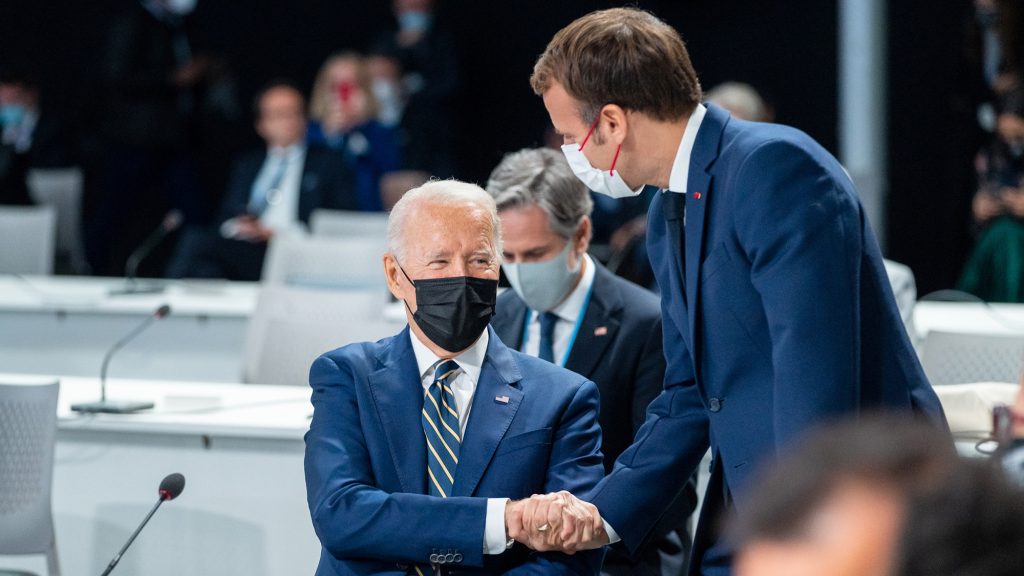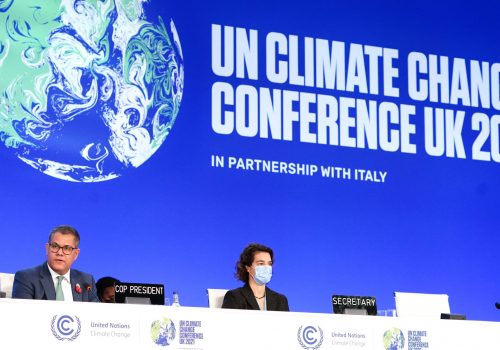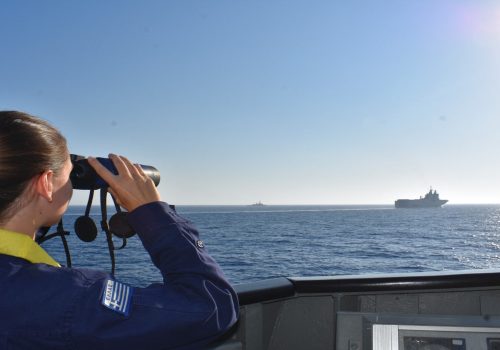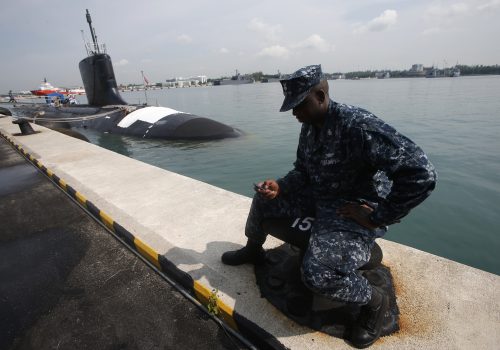After the AUKUS defense pact strained ties between Washington and Paris in September, presidents Joe Biden and Emmanuel Macron appeared to make concrete progress in patching things up in Rome last month. Now, there is a renewed impetus to foster cooperation where the two countries share mutual interests—and one realm worth exploring, but which has so far been ignored, is climate security. It has the potential both to reduce tensions and to make concrete progress on bilateral cooperation. As French ambassador to the United States Philip Etienne put it when discussing AUKUS: “Every crisis is an opportunity.”
Often deployed side-by-side, both countries are well aware of the challenges posed by climate imbalance, both in adaptation and in mitigation, and their militaries are among the few taking it increasingly into account in their strategic thinking, operational planning, and capability building. While the US Department of Defense released its Climate Adaptation Plan and Defense Climate Risk Analysis Report last month—with a Sustainability Report and Implementation Plan yet to come—France has published several strategies of its own in recent years related to green defense and climate security, most recently the defense energy strategy and a plan to preserve biodiversity. Back in 2015, it launched the Observatory on Defense and Climate to analyze the geopolitical and security issues created by climate change. Still, France does not have a comprehensive strategy encompassing all the dimensions of climate security. The next bilateral strategic dialogue between France and the United States could thus address this issue. It would send the political signal that climate security is a high-level priority and lead to bilateral working groups between experts. It would provide the opportunity to share assessments on the impact of climate change on threat analysis to foster common understanding. These kinds of discussions would nurture strategic thinking in both countries, influencing the forthcoming US National Defense Strategy and helping the French Ministry for the Armed Forces to finally produce a proper climate defense strategy.
Both countries took a step in the right direction to foster cooperation this month at the Paris Peace Forum, where they signed a “joint statement on climate change and the armed forces” along with twenty-three other countries by acknowledging the need “to play our part in combatting climate change as well as preparing our forces for the impacts of climate change and the energy transition.” Indeed, both sides recognize the need for cooperation: In 2015 France organized the first international ministerial convention on climate and defense, while a soon-to-be-created role at the US Department of Defense will oversee climate change response and may be particularly committed to engaging its partners across the world. Now there is a need to translate these statements into concrete action.
While both countries are prepared to engage their partners in building the necessary capacity to jointly address the hazards of climate change, they must ensure coordination through regular dialogue to ensure these investments are allocated in the most efficient way.
Any enhanced bilateral cooperation should also include other partners, whether NATO, the European Union (EU), or other regional bodies. Both France and the United States already participate in the Pacific Environmental Security Forum—which brings together Pacific nations’ militaries, civilian agencies, and non-governmental organizations to forge environmental solutions. The United States and France should favor increased climate cooperation between the EU and NATO, and at the moment both organizations are stepping up (with the EU Climate Change and Defense Roadmap and NATO Climate Change and Security Action Plan for instance). In this joint effort, the EU could be considered as a NATO strategic partner. The United States and France should also officially support the Canadian proposal to host a NATO Center of Excellence on Climate and Security. This center could be designed like the Hybrid Center of Excellence based in Finland, which is a platform for both NATO and the EU.
Meanwhile, adapting their missions, infrastructure, equipment, and training to the effects of climate change is another challenge for the US and French armed forces. Here’s how they can improve on each point:
1. Missions: French and US armed forces often lead Humanitarian Assistance and Disaster Relief operations and will do so more in the future. To do so effectively, each country needs to know what capabilities the other has—and where they’re located—to deliver military assistance during fires, hurricanes, or other natural disasters. The difficult coordination of operations among the Netherlands, France, and the United Kingdom after Hurricane Irma hit the Caribbean in 2017 led to the creation of the Multinational Caribbean Coordination Cell, aimed at streamlining air and sea efforts to deliver aid. Wherever the need might arise, France and the United States, along with other partners, could foster such flexible cooperation to better coordinate their capabilities. France and the United States could lead such an effort in the South Pacific, for instance, an opportunity for renewed cooperation in the Indo-Pacific in the post-AUKUS context.
2. Infrastructure: Risk assessments of infrastructure are a priority for both countries. France is especially concerned about its overseas installations in the South Pacific and West Africa, where the effects of climate change are greater. For its part, the United States will also complete a climate exposure assessment of all its major installations abroad by April 2022. There is much to gain from increased dialogue on how to conduct such analyses, particularly about how to limit the vulnerability of critical infrastructure.
3. Equipment: On this challenge, taking into account climate change’s impacts must play a greater part in designing and modernizing key equipment, from soldiers’ clothing to sonar devices. While the French General Directorate for Armament is currently considering this issue, the US Department of Defense also acknowledges that mission success “will depend on… forces, equipment, and capabilities engineered to adapt to and withstand more extreme environments.” The two countries could thus find synergies in industrial cooperation.
4. Training: The French military has already participated in five exercises with Arctic countries in extreme-cold conditions, and it was the second-largest participant (apart from host countries Sweden, Finland, and Norway) in the Arctic Challenge 2019 exercise. The United States, which trains regularly in such conditions, was the largest. In May the Pentagon also held the first edition of its climate and environmental security tabletop exercise, Elliptic Thunder. Future exercises should include greater participation of allies and partners, according to Annalise Blum, a senior advisor for climate at the Pentagon.
Both the United States and France are determined to move forward after AUKUS by enhancing cooperation. They are also already committed to tackling climate change at the security level, keeping in mind that operational efficiency must be preserved at all times. Cooperating on climate security, while beneficial to their strategic thinking and future operations, can strengthen this critical bilateral partnership.
Marie Jourdain is a visiting fellow at the Atlantic Council’s Europe Center and previously worked for the French Ministry of Defense’s Directorate General for International Relations and Strategy.
Further reading
Fri, Nov 12, 2021
COP26 is coming to a close. Here are the wins and losses.
New Atlanticist By Dan Peleschuk
We pulled together a selection of our experts' commentary on what mattered at COP26 (and what didn't).
Thu, Oct 7, 2021
Greece and France give European strategic autonomy a shot
New Atlanticist By Katerina Sokou
A new defense pact between the two aims to address instability in the Mediterranean by tackling multiple challenges in the region.
Wed, Sep 15, 2021
Experts react: The US, UK, and Australia struck a nuclear submarine deal. What does it mean?
New Atlanticist By
The pact, known as AUKUS, is a clear challenge to China in the Indo-Pacific and a deepening of military ties among close allies of more than a century.
Image: US President Joe Biden shakes hands with French President Emmanuel Macron at the United Nations Climate Change Conference COP26 in Glasgow, Scotland, on Monday Nov 1, 2021. Photo via Reuters.



